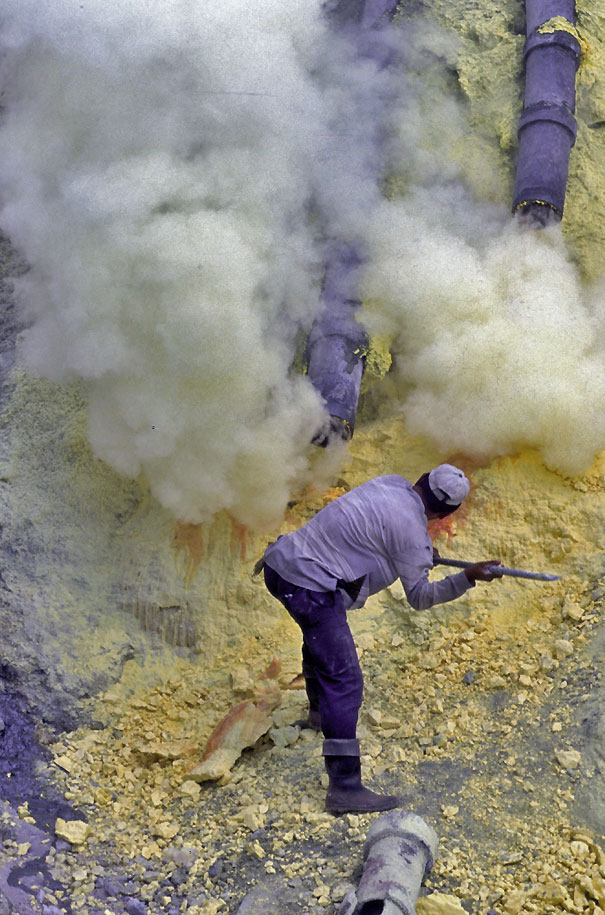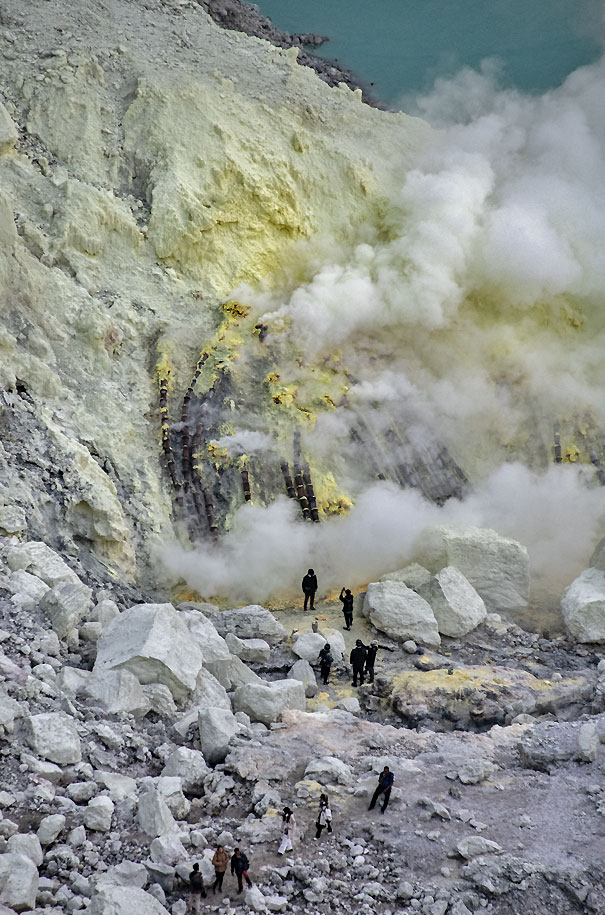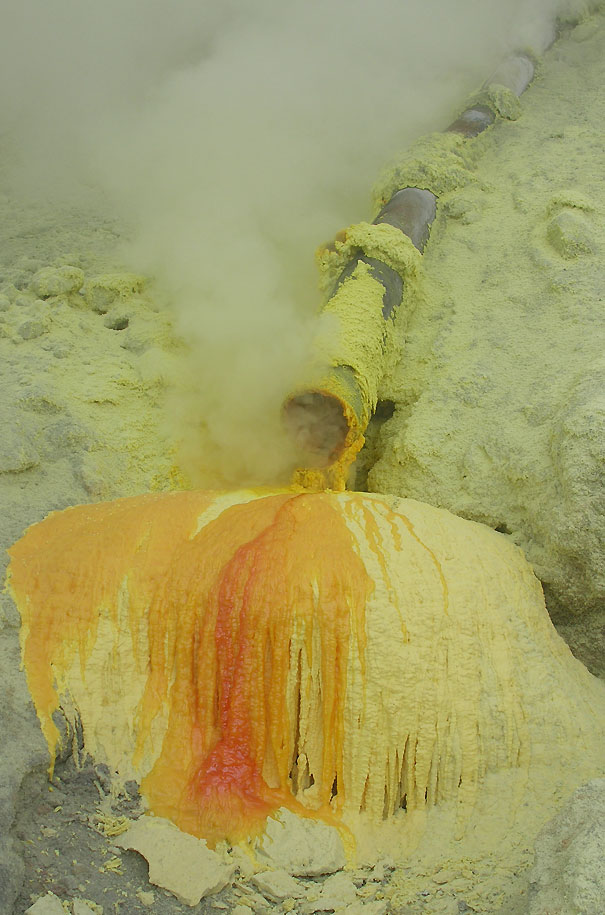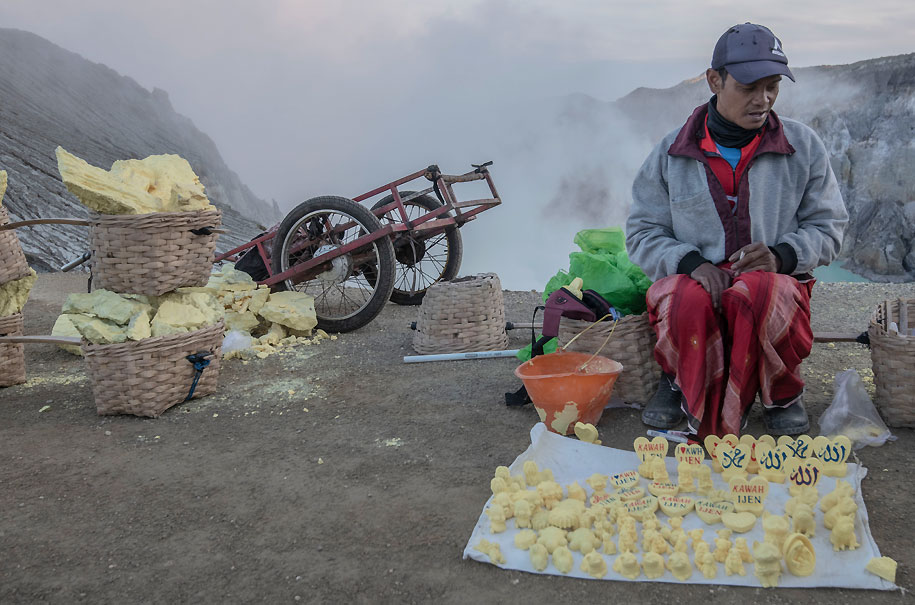Javanese Sulfur Collectors

A few years ago I heard a tourist lament that you can no longer see people bathing by the roadside in rural Bali and I remember thinking “that may be a shame for you but they’re probably happier not having their photo taken going to the bathroom.” The situation with the sulfur collectors in Java is similar.
I first hiked up Kawah Ijen, an active volcano just across the narrow straight from Bali, in east Java, in the early 1990’s. The road north from the town of Banyuwangi to Paltuding, which at that time was a tiny outpost marking the start of the climb to the actual crater, was so bad that it was necessary to use a 4 wheel drive. Even then things had already improved for the sulfur collectors as prior to the road I was told they had to carry their load approximately 15km down to the warehouse where the sulfur was weighed and stored.

My only company on the hike was a group of slightly built Javanese men, dark skinned from constant exposure to the harsh tropical sun and with fragrant kretek (clove) cigarettes dangling from their chapped lips. I have since hiked Ijen maybe a dozen times and on each occasion there are more ‘visitors’ and less sulfur collectors with maybe a thousand hikers and a single collector in May 2024. On a (purely selfish) level I resented the intrusion into what used to be my private tourist attraction but I am also aware that life for the sulfur collectors has become so much easier and I have no right to begrudge them this.

These first few images are scans of slides taken before digital photography.

Before tourism the sulfur collectors would rise at around midnight, down a quick coffee and huddle in sarong-clad groups along the roadside to wait for the truck that would take them up to Paltuding. There they collected their baskets and began the hike up the outer rim of the Ijen crater, all the while puffing on kreteks, arriving at the top just before sunrise.

As a tourist, reaching the edge of the crater is a chance to rest and appreciate the magnificent view of the caldera; vivid yellow smoke gushes from fissures in the crater wall, beside a turquoise lake of sulfuric acid. Of course, none of this is of interest to the sulfur collectors who immediately commence the steep descent down the narrow, rocky path to the caldera floor, a journey that was largely off limits to tourists until the blue flames of the burning sulfur became a social media sensation.

.

Without intervention much of the sulfur escapes from the crevices as thick yellow smoke that dissipates in the wind. To prevent this, lengths of ceramic pipe are wedged into the crevices enabling the smoke to cool, liquefy, and eventually solidify as it emerges from the end of the pipe. On the caldera floor the sulfur collectors use heavy iron bars to break up the solid sulfur and load it into baskets.



It is difficult to imagine without first hand experience how dangerous and generally unpleasant this task is! Clouds of sulfur smoke and gas frequently envelope the area making it impossible to do anything other than bend over and cough, until the air clears. It was only on my most recent trip that I saw the sulfur collectors using anything approaching proper breathing apparatus as their usual ‘trick’ was to wind a shirt around their face.
The sulfur collectors are paid per kilogram of sulfur they deliver to the gudang (warehouse) so it’s in their own interest to load themselves up. It is not uncommon for them to fill each basket with more than 40 kilograms of sulfur, an 80 to 100 kilograms (220lbs) total for both baskets, which are lugged back up the rocky path to the crater rim, and then back down the outside of the crater to the start point. The weight exerted by the baskets causes such deep bruising that the shoulders of many of the collectors are a permanent purplish black. It takes an hour from the crater floor back to the rim, and another 2 hours from the rim down to Paltuding, so even without the long walk back to the gudang the collector carries more than his own body weight along a steep stony path for close to 3 hours.
As of May 2024 the sulfur collectors receive Rp1,250 for each kilogram of sulfur so an 80kg (175lb) load would pay Rp100,000 (AU$10.00 or US$6.15). There is no sick pay, health cover, annual leave, superannuation or other benefit; not being able to work simply means no earnings.

A local man sells souvenirs made from sulfur, on the rim of the caldera.
Contrast this with the income and general work conditions of the sulfur collectors now that Ijen has been ‘discovered’ by tourists. I have no information on the amount they are paid as mountain guides but my guide received more than $10 in tips, there are sales of sulfur souvenirs, and many of the less physical hikers actually paid to be hauled up the side of the crater in a cart at a cost of about $100 each way. This is a much better income for a far easier job so I can’t help but wonder about the future of sulfur collecting.